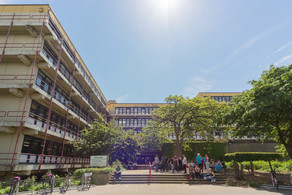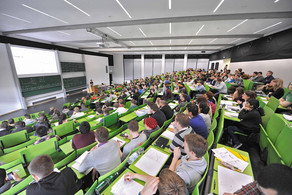Teaching
I have established a lecture series on the Science of Synthesis (Synthesewissenschaft) that aims to teach students about available and valuable methods for selective structural manipulation of organic molecules. The course illustrates opportunities and illuminates limitations of the currently available synthetic methodology. I will outline ways and means – tactics and strategies – for the selective structural manipulation of structurally complex molecules with relevance to medicinal chemistry, materials chemistry, and natural product chemistry. To (pre)serve the purpose, my lecture series is based exclusively on examples from the contemporary original literature. By design, relevance with respect to the current state of the art is thus secured. The lecture series doesn’t shy away from the unexpected or the unexplainable experimental results nor from the exceptions from the rule. Hence, the lecture series was not designed to hide but rather to introduce to intellectual ambiguities in this field of research. For more information, please visit Moodle of the TU Dortmund.
"Einführung in die Synthesewissenschaften (MOC2V)"
(1) radikalische Substitution am sp3-Kohlenstoffatom I; (2) radikalische Substitution am sp3-Kohlenstoffatom II; (3) nucleophile Substitution am sp3-Kohlenstoffatom I; (4) nucleophile Substitution am sp3-Kohlenstoffatom II; (5) 1,2-Eliminierung zu C/C-Doppelbindungen; (6) Addition an C/C-Mehrfachbindungen; (7) Substitution am Aromaten I; (8) Substitution am Aromaten II; (9) Reduktion von Carbonylverbindungen; (10) Oxidation am Kohlenstoffatom; (11) nucleophile Substitution am Carbonylkohlenstoffatom; (11) Acetale, Imine, Enamine, Oxime, Hydrazone; (12) Enole; Mannich-Reaktion; Enolate; (13) Enolate; Aldolreaktion; (15) Claisen-, Dieckmann-, Knoevenagel-Kondensation; (16) Enolate: Alkylierung; Michael-Addition; (17) metallorganische Verbindungen; Magnesiumorganyle; (18) Lithiumorganyle; (19) Phosphororganyle: Wittig-Reaktion; (20) Palladium-katalysierte C/C-Bindungsbildungsprozesse: Heck-Reaktion; Kreuzkupplungen; (21) Ruthenium-katalysierte C/C-Bindungsbildung: Ringschlussolefinmetathese; (22) Einführung in die statische Stereochemie; (23) Synthese und Selektivität; stereodifferenzierende Synthese; (24) Methoden der asymmetrischen Synthese I; (25) Methoden der asymmetrischen Synthese II; (26) Carbonsäureaktivierung; (27) perizyklische Reaktionen I; (28) perizyklische Reaktionen II; (29) Naturstoffe I; (30) Naturstoffe II
"Einführung in die Synthesewissenschaften (MOC2V)"
(1) radikalische Substitution am sp3-Kohlenstoffatom I; (2) radikalische Substitution am sp3-Kohlenstoffatom II; (3) nucleophile Substitution am sp3-Kohlenstoffatom I; (4) nucleophile Substitution am sp3-Kohlenstoffatom II; (5) 1,2-Eliminierung zu C/C-Doppelbindungen; (6) Addition an C/C-Mehrfachbindungen; (7) Substitution am Aromaten I; (8) Substitution am Aromaten II; (9) Reduktion von Carbonylverbindungen; (10) Oxidation am Kohlenstoffatom; (11) nucleophile Substitution am Carbonylkohlenstoffatom; (11) Acetale, Imine, Enamine, Oxime, Hydrazone; (12) Enole; Mannich-Reaktion; Enolate; (13) Enolate; Aldolreaktion; (15) Claisen-, Dieckmann-, Knoevenagel-Kondensation; (16) Enolate: Alkylierung; Michael-Addition; (17) metallorganische Verbindungen; Magnesiumorganyle; (18) Lithiumorganyle; (19) Phosphororganyle: Wittig-Reaktion; (20) Palladium-katalysierte C/C-Bindungsbildungsprozesse: Heck-Reaktion; Kreuzkupplungen; (21) Ruthenium-katalysierte C/C-Bindungsbildung: Ringschlussolefinmetathese; (22) Einführung in die statische Stereochemie; (23) Synthese und Selektivität; stereodifferenzierende Synthese; (24) Methoden der asymmetrischen Synthese I; (25) Methoden der asymmetrischen Synthese II; (26) Carbonsäureaktivierung; (27) perizyklische Reaktionen I; (28) perizyklische Reaktionen II; (29) Naturstoffe I; (30) Naturstoffe II
"Synthesewissenschaften I"
(1) radikalische C/C-Bindungsbildung; (2) nucleophile Substitution am sp3-Kohlenstoffatom; (3) Übergangsmetall-katalysierte Substitutionen am Aromaten; (4) Synthese von C/C-Mehrfachbindungen durch Kondensationsreaktionen; (5) Lithiumorganyle; (6) Aldoladditionen unter asymmetrischer Induktion I; (7) Aldoladditionen unter asymmetrischer Induktion II; (8) Palladium-katalysierte C/C-Bindungsbildungsprozesse; (9) Metathese mit Rutheniumcarbenkomplexen I; (10) Metathese mit Rutheniumcarbenkomplexen II; (11) Kettenverlängerung, Ringexpansion und Ringkontraktion durch nucleophile [1,2]-Umlagerungen; (12) Claisen-Umlagerungen; (13) Diels−Alder-Zykloadditionen; (14) elektrophile Additionen an C/C-Doppelbindungen; (15) Fotochemie
"Synthesewissenschaften II"
(1) radikalische C/C-Bindungsbildung; (2) Palladium-katalysierte C/C-Bindungsbildungsprozesse; (3) Dreiringsynthese: Zyklopropanierung; (4) Fünfringsynthese: Pauson–Khand-Reaktion; (5) Fünfringsynthese: Nazarov-Zyklisierung; (6) Fünf- und Sechsringsynthese: intramolekulare Aldol-Kondensation, Robinson-Annelierung und Hajos−Parrish-Reaktion; (7) Siebenringsynthese: Cope-Umlagerung; (8) Siebenringsynthese: Rhodium(I)-katalysierte intramolekulare (5+2)-Zykloaddition; (9) Pyrroldinsynthese durch 1,3-dipolare Zykloadditionen mit Azomethinyliden; (10) 1,2-Oxazolidinsynthese und Zugang zu γ-Aminoalkoholen durch 1,3-dipolare Zykloadditionen mit Nitronen; (11) nucleophile 1,2-Umlagerungen zum Stickstoffatom; (12) C(sp3)−H-Oxidation; (13) Fotoredoxkatalyse
"Synthesewissenschaften III"
(1) radikalische C/C-Bindungsbildung; (2) Achmatowicz-Reaktion; (3) Fischer-Indolsynthese; (4) Pictet−Spengler-Reaktion, Bischler−Napieralski-Reaktion; (5) Pinakol- und Semipinakol-Umlagerungen; (6) Knoevenagel-Kondensation; (7) Dieckmann-Kondensation; (8) Mannich-Reaktion; (9) Nicholas-Reaktion; (10) C/C-Bindungsbildung durch C(sp3)−H-Insertion; (11) Zyklisierungskaskaden I; (12) Zyklisierungskaskaden II; (13) Fotochemie





